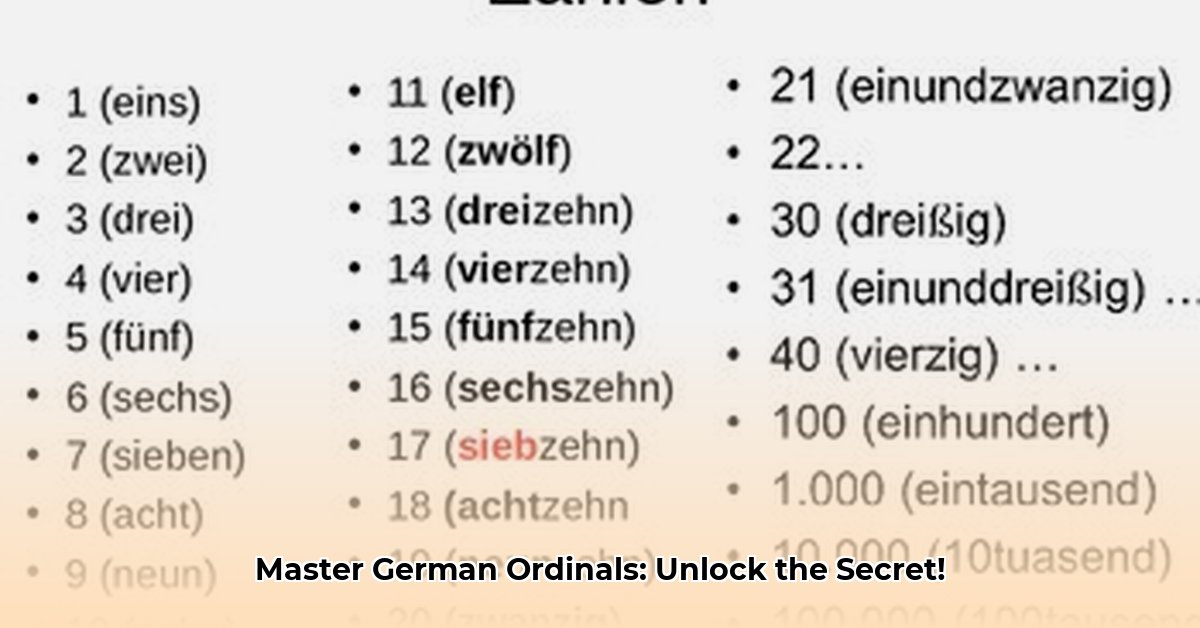
Let's conquer German ordinal numbers – those words like "first," "second," "third," and so on. They might seem daunting at first, but with a structured approach, you'll master them. Unlike English, German ordinals follow a more systematic, albeit slightly complex, pattern. This guide will break down their formation, declension, and usage, enabling you to confidently incorporate them into your German.
Forming German Ordinals: Unveiling the Patterns
German ordinals are formed primarily by adding suffixes to cardinal numbers (one, two, three, etc.). However, some irregularities exist, especially for lower numbers.
The Unique "First": The word for "first" ("erst-") is an exception to the general rule.
The Dominant "-te" Suffix: This suffix is used for most ordinals, typically starting from "second" ("zweit-") and "third" ("dritt-"). For numbers above 20, simply add "-te" to the cardinal number. For instance, "21st" is "einundzwanzigste."
Here's a table illustrating the patterns for the ordinals 1-20:
| Cardinal Number | Ordinal Number | Cardinal Number | Ordinal Number |
|---|---|---|---|
| 1 | erst- | 11 | elfte |
| 2 | zweite | 12 | zwölfte |
| 3 | dritte | 13 | dreizehnte |
| 4 | vierte | 14 | vierzehnte |
| 5 | fünfte | 15 | fünfzehnte |
| 6 | sechste | 16 | sechzehnte |
| 7 | siebte | 17 | siebzehnte |
| 8 | achte | 18 | achtzehnte |
| 9 | neunte | 19 | neunzehnte |
| 10 | zehnte | 20 | zwanzigste |
Note that irregularity is present for numbers 1-3 and then for 11-20. The pattern for numbers greater than 20 becomes more consistent.
Declining Ordinals: The Art of Adaptability
The complexity of German ordinals lies in their declension, which is similar to how adjectives change. Ordinals inflect based on case (nominative, accusative, dative, genitive), gender (masculine, feminine, neuter), and number (singular, plural). Think of them as chameleon-like adjectives, adapting their form to match the noun they modify.
Let's illustrate the declension of "zwanzigste" (20th):
| Case | Masculine Singular | Feminine Singular | Neuter Singular | Plural |
|---|---|---|---|---|
| Nominative | der zwanzigste | die zwanzigste | das zwanzigste | die zwanzigsten |
| Accusative | den zwanzigsten | die zwanzigste | das zwanzigste | die zwanzigsten |
| Dative | dem zwanzigsten | der zwanzigsten | dem zwanzigsten | den zwanzigsten |
| Genitive | des zwanzigsten | der zwanzigsten | des zwanzigsten | der zwanzigsten |
This pattern largely applies to other ordinals. Remember to always consider the gender and case of the noun.
Ordinals in Context: Real-World Applications
German ordinals are versatile and appear in various contexts:
- Dates: Der 1. Mai (May 1st)
- Rankings: Der erste Platz (first place)
- Lists: Der erste Punkt (the first point)
- Sequential Ordering: The ordinal will take the case associated with the sequential element it modifies. For instance, “in the second chapter” would be “im zweiten Kapitel” (dative case).
Abbreviations and Roman Numerals: Efficient Alternatives
Abbreviations such as "1.", "2.", "3." are common. Roman numerals (I, II, III, etc.) appear in formal contexts, like chapter numbers or specific titles.
Common Pitfalls and How to Sidestep Them
A frequent mistake is neglecting the declension of ordinals. Treat them as adjectives; they must agree in gender, number, and case with the noun they modify.
Practice Exercises: Solidify Your Understanding
Practice is crucial for mastering German ordinals. Try declining the following: 35th, 112th, and 2024th in all cases and genders. Create sentences using these ordinals in context. Consistent practice will build your confidence and fluency.
Conclusion: Your Journey to Ordinal Mastery
Mastering German ordinals enhances your overall language proficiency. While initially challenging, understanding the systematic formation and declension rules, along with consistent practice, will lead to fluency and accuracy. Embrace the challenge, and you'll soon be confidently navigating the nuances of German ordinals.